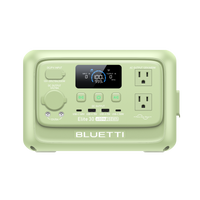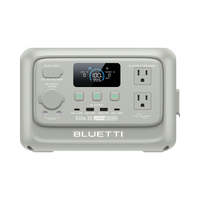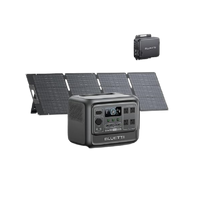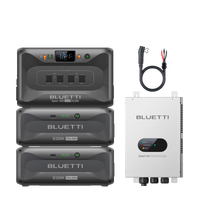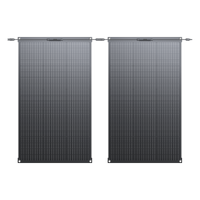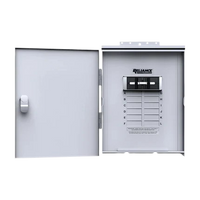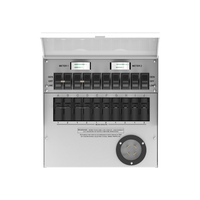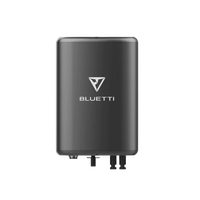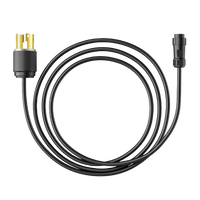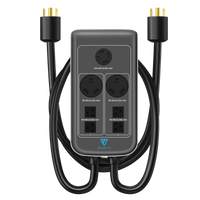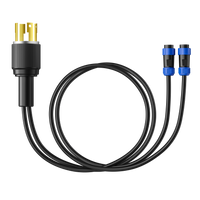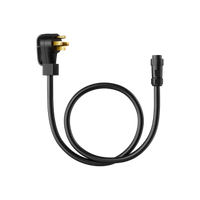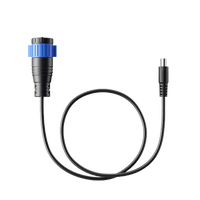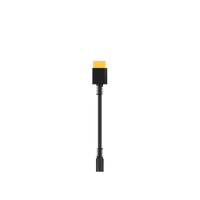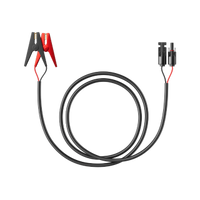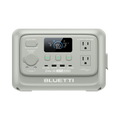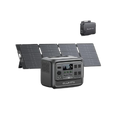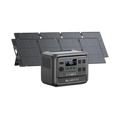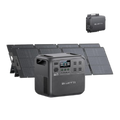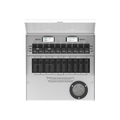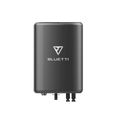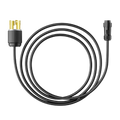Televisions are the most common gateway to the entertainment world after smartphones, laptops, and tablets. Technology has significantly advanced from bulky CRTs to today's sleek, intelligent, and flat TVs.
Understanding their wattage requirements will help you decide to buy energy-efficient TV models and their impact on electricity bills. They can use anywhere between 50 and 200 watts of electricity. However, their usage depends on the model, type, and other factors.
As electricity costs continue to rise, understanding their power usage and practicing power-saving tips can help save money. This article aims to give you a deep understanding of energy requirements and ways to become energy-efficient.
Types of TV: How Many Watts Does a TV Use?
TVs have different wattage depending on their type and model. They used anywhere between 50 and 200 W. Older CRTs were much more power-hungry than the modern LCDs. The different types of TV models include the following:
|
Screen Size (Inches) |
LED (W) |
OLED (W) |
LCD (W) |
CRT (W) |
Plasma (W) |
|
22 |
15-30 |
40-60 |
20-50 |
50-120 |
- |
|
32 |
30-50 |
60-80 |
40-70 |
70-140 |
- |
|
42 |
40-60 |
80-100 |
60-90 |
90-160 |
150-300 |
|
55 |
50-80 |
100-120 |
70-100 |
120-200 |
200-400 |
|
65 |
70-100 |
120-150 |
90-130 |
150-250 |
250-350 |
Wattage Range of Different TVs
CRT (Cathode Ray Tube) TVs
Cathode Ray Tube TVs are the older, bulkier televisions that dominated from the mid-20th century until the early 200s. It had a standard definition resolution, and their wattage depended on their size and resolution.
Larger CRTs used more power and ran via electron beam to create images on a phosphorescent screen. They have been replaced with newer TV technologies like LCD and LED. However, they offered good colour accuracy and response times, and their wattage requirements ranged from 50 to 250W.
Moreover, their brightness and contrast settings significantly influenced their energy consumption. Their power usage was considerable in standby mode as well. Their built-in audio components also contributed to their energy usage.
LCD (Liquid Crystal Display) TVs

Liquid Crystal Display TVs became popular in the mid-2000s and are still used today. They provide a better resolution and are much slimmer than CRTs. They utilize a liquid crystal solution between two layers of glass, backlit by fluorescent lamps.
However, they may suffer from color accuracy and lower contrast compared to more modern TVs. LCD TVs' energy requirements range from 20 to 130W and are more energy efficient than CRT TVs.
They share the same brightness and contrast, but you can change them. Moreover, their energy efficiency has increased with recent advancements in technology. They also use less energy during standby mode.
Plasma TVs
Plasma TVs were popular between the mid-200s and 2010s and were well-known for wider viewing angles and better color accuracy. They generated images by ionizing gas to generate plasma, emitting ultraviolet light, exciting phosphors and producing visible light.
However, they went out of production due to their large energy requirements. Their wattage ranged from 150 to 400W and was soon replaced by more efficient LED and LCD technologies. They also caused concerns about screen burn-in, so it is not in production anymore.
Plasma TVs were renowned for their contrast ratios and brightness levels. Newer models became energy-efficient over time but failed to meet the efficiency expectations against other types of TV.
LED (Light Emitting Diode) TVs
Light-emitting diode TVs are a variation of LCD TVs that emerged in the late 200s with improved energy efficiency and thinner designs. They use light-emitting diodes to generate images on the display.
They come in edge-lit and full-array, with the latter offering better contrast levels and uniform backlighting. Their wattage requirements range from 15 to 100W, and they are prevalent for their energy efficiency.
LED TVs also allow precise control over brightness and dynamic contrast ratios to enhance visual quality. Moreover, their thin and lightweight design contributed to their aesthetic appeal.
OLED (Organic Light Emitting Diode) TVs
Organic Light Emitting Diode TVs are a variation of LED TVs introduced in the late 2010s. They are well-known for their thinner designs, deeper blacks, and superior contrast ratios. It also made them expensive but offered exceptional picture quality and was considered a premium option.
However, they consume more energy than LED TVs. Their wattage ranged from 40 to 150 W but offered precise controls to promote energy efficiency. They achieved true blacks by turning off individual pixels, translating to lower power requirements.
Moreover, their technology constantly evolves with better energy efficiency and cutting-edge display capabilities. Hence, they have become a reliable and innovative choice for most consumers in the long term.
Related articles: How Many Kwh Does the Average Home Use?
How Many Watts Do Air Fryers Use?
How to Calculate TV Wattage?

Televisions can contribute to the overall electricity costs, depending on their type, model, and usage. CRTs and Plasma TVs can dominate a chunk of electricity costs due to their high wattage requirements.
However, consumers readily switch to newer models like LED and LCD for aesthetic and energy efficiency. Hence, modern TVs consume anywhere between 50 and 150 W. Moreover, they also come with energy-saving features to reduce their power consumption.
You can check your TV's wattage by checking its amp and voltage. The information is provided in the yellow EnergyGuide label on the device. After that, you can multiply the amp and voltage to determine its wattage.
For example, if you have a device with an amp rating of 0.8333 amps and it operates at 120 volts, then:
Wattage = Amps × Volts
Wattage = 0.8333 amps × 120 volts
Wattage = 100
Therefore, your device's wattage would be precisely 100 W.
What are the Costs of Using a TV?
Most households use TVs for four hours or more per day. Hence, you can use it to find how much it contributes to electricity costs. You can use the following formula to find out your TV's energy usage and cost:
Energy (kWh) = (Power (Watts) × Time (hours)/1000
Let's say your TV consumes 100 W, and your average daily viewing time is 4 hours. Then, your average daily consumption will be:
Energy (kWh) = (100 x 4)/1000
Energy (kWh) = 400/1000
Energy (kWh) = 0.4
Therefore, your average consumption per day would be 0.4 kWh. Accordingly, it translates to 12 kWh per month and 146 kWh per year. Given the average cost of electricity at $0.1543 (cumulative average of different provinces), your monthly cost comes to $1.8516, and your yearly cost comes to $22.5148.
Here's a rough estimation of monthly and yearly costs depending on TV type.
|
Type of TV |
Wattage Range |
Average Time Usage (Hours/day) |
Daily Power Usage |
Average Cost per kWh |
Estimated Cost Per Month |
Estimated Cost Per Year |
|
CRT |
80-200 |
6 |
0.48 |
$0.1543 |
$6.96 |
$83.52 |
|
LCD |
40-120 |
6 |
0.36 |
$0.1543 |
$5.18 |
$62.16 |
|
Plasma |
150-400 |
6 |
1.50 |
$0.1543 |
$34.65 |
$415.80 |
|
LED |
30-100 |
6 |
0.18 |
$0.1543 |
$2.48 |
$29.76 |
|
OLED |
50-150 |
6 |
0.54 |
$0.1543 |
$7.39 |
$88.68 |
Power Saving Tips for TV Usage

You can save on electricity for using TV by following the tips below.
-
Switch Off When Not In Use
You may be surprised that your TV continues to use electricity when you turn it off by remote. When turned off, it goes into standby mode and may use around 2 to 5% of electricity. Therefore, you should turn the switch off as well to save further on electricity costs.
-
Adjust Brightness and Contrast
Higher brightness and contrast settings demand more power for the TV's backlight. Hence, you can head to settings and adjust it to what is most comfortable for your viewing pleasure. It can help you become energy-efficient without compromising picture quality.
-
Utilize Energy-Saving Features
Most modern LCD, LED, and OLED TVs have built-in energy-saving features. Some common ones include eco-mode, sleep timers, and automatic brightness control. Using these features can help reduce your device's overall power consumption.
-
Upgrade to Newer Models
Televisions are constantly improving in quality and energy efficiency. Hence, you should consider buying a new TV if you're still stuck with an older model. It will help you save on electricity costs in the long run.
-
Use Alternate Power Sources
You can save on electricity by powering your TV and other appliances via an alternative power solution. They produce electricity through various means, such as solar energy, to store and provide electricity. Hence, you can use them to power your TV without relying on your house's main electricity.
Save Money With Solar Generators
Solar generators contain solar panels, inverters, and batteries to convert sunlight into electricity. Investing in a solar energy system can help reduce your reliance on the traditional grid and save money in the long run. Moreover, it can also earn you money via tax rebates and incentives.

The BLUETTI AC200P solar generator kit offers an affordable solar energy solution with a 2000 Wh capacity. It has a good battery life of 3500+ cycles up to 80%. Moreover, you can recharge it in seven ways, including solar and AC. Additionally, it has seventeen outputs to run multiple devices. The AC200P provides a reliable off-grid power source to save money on electricity bills.

Alternatively, consider the BLUETTI AC300 + B300 solar generator kit for a more comprehensive solution. It has a greater capacity of 3000W to provide a 24/7 UPS home backup. Like the AC200 P, it has an excellent battery shelf life of 3500+ cycles up to 80%.
Moreover, it has a 240V split phase bonding with fast dual charging capability. You can also recharge it in seven ways and keep your home powered for days during power outages.
Related articles: How Do Portable Solar Panels Save You Money?
Can You Power a House with a Solar Generator in Canada?
Final Thoughts
To summarize, TVs have come a long way from the traditional CRTs to become energy-efficient and provide better picture quality. The latest LCD and LEDs have a standard wattage range of 50 to 150 W with built-in energy-saving features. Accordingly, you can utilize these features to help save on electricity costs and energy usage. On the other hand, consider investing in a solar generator kit, such as the BLUETTI AC200P and AC300+B300. They can help reduce your reliance on the traditional grid and save money on electricity in the long run.














